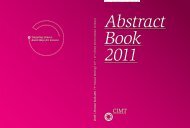Abstract Book 2010 - CIMT Annual Meeting
Abstract Book 2010 - CIMT Annual Meeting
Abstract Book 2010 - CIMT Annual Meeting
You also want an ePaper? Increase the reach of your titles
YUMPU automatically turns print PDFs into web optimized ePapers that Google loves.
073 Suso | New targets & new leads<br />
Identification of novel CD4+ and CD8+ T cell epitopes from<br />
telomerase (hTERT)<br />
Else Marit Inderberg Suso 1 , Anne-Marie Rasmussen 1 , Sissel Trachsel 1 , Steinar Aamdal 2 ,<br />
Svein Dueland 2 , Gunnar Kvalheim 3 , Gustav Gaudernack 1<br />
1 Section for Immunology, Oslo University Hospital-Radiumhospitalet, Norway<br />
2 Dept for Clinical Research, Oslo University Hospital-Radiumhospitalet, Norway<br />
3 Section for Cell Therapy, Oslo University Hospital-Radiumhospitalet, Norway<br />
118<br />
We have a number of patients who have been vacci-<br />
nated with the telomerase peptide vaccine GV1001<br />
or with dendritic cells (DCs) loaded with hTERT<br />
mRNA.<br />
Among these patients, several have had an extraordinary<br />
clinical course, involving disease stabilization<br />
over many years, partial and even complete<br />
remission of the disease. These patients offer a<br />
unique opportunity to study in detail the immune<br />
response against the vaccine.<br />
We have identified several novel hTERT epitopes by<br />
studying responses against a panel of 24 overlapping<br />
15-mer hTERT peptides as well as one 30-mer<br />
peptide. The results indicate that a profound epitope<br />
spreading within the hTERT antigen takes place in<br />
some patients following vaccination with a single<br />
T helper epitope (GV1001), and that many of these<br />
epitopes are recognized also following vaccination<br />
with hTERT transfected DCs. CD4+ T-cell clones<br />
specific for some of these peptides have been generated.<br />
In addition, CD8+ T cells specific for novel<br />
hTERT epitopes have been identified by pentamer<br />
staining.<br />
The recognition of these epitopes in a large number<br />
of patients further indicates a high degree of immunogenicity<br />
and HLA promiscuity. This also suggests<br />
that these peptides may be clinically relevant<br />
epitopes. Their identification is important for the<br />
development of the next generation of immunotherapy.<br />
We are now developing a second generation<br />
of hTERT peptide vaccines as well as T-cell receptor<br />
transfer based on “clinically validated” T cell receptors<br />
cloned from long term survivors.



